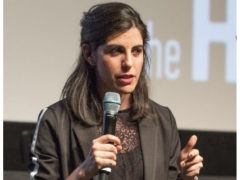Lean into using your phone: Q&A with Sarah Singer

Sarah Singer is the senior director of innovation at Vice. I spoke to her about how Vice cultivates its presence and engagement across social platforms.
What is your role at Vice?
At Vice I lead a team that is focused on digital innovation. Really what that means is figuring out the best way to tell stories in different parts of the Internet and on different platforms to reach new and diverse audiences. Most of the format we work in is video. A lot of the emerging spots on the Internet are video or visual, though certainly not all of them. But we are working primarily at this moment within the mobile video ecosystem and really trying to figure out how we can build consistent young audiences around Vice video content.
The brand Vice, of course, has been a leader in things like the video and visual journalism space for many years. There’s a significant presence that the organization has on YouTube. Part of that strategy is multi-pronged, one of which is re-cutting and reframing and tightening and optimizing some of the longer form video content on YouTube to best serve audiences on other emerging platforms. Another part of it is producing original work for these audiences in vertical, specifically.
What are the social channels that you are focusing on right now? What do you see as the most lucrative for Vice in terms of engaging your audience?
We definitely have the biggest audience on Snapchat. There’s several different kinds of ways that we engage with that platform. There are individual shows that we program that have set audiences. One Star Reviews is a great example of that. We also work closely with our U.K counterparts and program an English language, global edition. That’s four videos a week that we ship across the U.S. and the U.K. There’s other shows, like Sneakers. We have one called High Octane, for example, and other ones that we’ll have in the coming months that are proven successful Vice video franchises on Snapchat specifically. We’ve also learned a lot such ass what kind of narratives really resonate, so we can program really to the audience. When there’s so much video content at Vice, it’s nice to be able to give the audience the entertainment type videos that we know that they’re waiting for. So in terms of scope, Snapchat is big.
We also have a significant presence on Instagram. On Instagram, there’s a hybrid approach, looking at vertical video and IGTV and in the stories. But also there’s really great ways to visualize text and tap through to swipe up to articles too, and this we collaborate closely with our social publishing team on that platform.
We also are working with Google on a project that actually launched today called Google Web stories. That is Google’s visual storytelling product for mobile. So they’re tap-through articles and videos that are on the web, as opposed to in a closed platform like Instagram, or Snapchat. That has been definitely a challenge, but it’s a good one to have. It’s an important exercise for us to keep leaning into and learning. At its core, Vice is a content company, so we want to be producing content that resonates with people. So it’s a balancing act that we are working on, such as how Tik Tok-y do we want to be? How Vice-y do we want to be? What’s the middle ground that serves both purposes?

How do you cultivate the unique Vice style voice?
I collaborate a lot with our head of digital video, and our head of editorial. There’s two parts of this. What’s the Vice way into storytelling? What are the ways that we would cover cultural trends? We would cover lifestyle and trends that are unique to Vice. So from the content like this for each choice, there’s a consistency there with how we approach certain topics. And then in terms of the format, there’s a visual language that is really clear from Vice that we want to translate to these off-platform experiences. Our senior animator, who’s a really talented artist, is the best in that he’s able to translate Vice’s kind of branding and language to meet the platforms. We use the tools that are in the platforms themselves to a certain extent, so that the content feels native, but it also feels Vice.
I think there’s certain editorial lenses through which Vice storytelling thrives. Access is a big one of them, being there. Immersive is a word that is used a lot within the organization. Really giving users an opportunity to experience people in places outside of what they’re comfortable with. And we’re able to figure out unique ways to do that through these mobile video storytelling products, as well as through the reporting process on the written side and through more of the produced video that comes out of the digital video teams. So there’s a philosophical kind of Vicey-ness, there’s visual Vicey-ness and then there’s content and angle, that is part of the brand’s overall approach. We work hard to have thorough lines and consistency across all of our digital content so that it feels cohesive and not random or distracted by any means.
What does a successful Instagram TV story look like? What are the characteristics? What boxes are you checking?
If we’re doing something for IGTV, we want it to be edited for vertical and take advantage of the 9:16. On social feeds, for example, it has to be a tight arc, a very tight narrative arc that gets right to the story. Instagram itself is a pretty curated platform. It’s a little bit more curated than Tik Tok, for example, which tends to be a little bit more homegrown, a little more like everybody’s home video. Instagram is a little more polished. We’ve found personal stories, where you get an intimate experience with the narrator, or with the subject close up and personal with them tend to do well. It’s like how people communicate with their friends on that platform anyway. So the more that we can be aligned to how people naturally film themselves on that platform in our storytelling, the better engagement will be, because it establishes an authenticity for why we’re there in the first place.
What are your team’s favorite tools or tech for making social content?
I think what’s been amazing about producing during the pandemic is you are able to actually do a lot with a little. We shoot, we do a lot of screen recording, we do a lot of iPhone stuff, found footage, and edit in the app when possible. In terms of the ways that we’ve been able to do it, it’s really leaning into the constraints of the moment, leaning into having our subjects film and send us footage. We can’t necessarily get there as easily but it doesn’t mean that we have to have boring footage. You just empower different types of people to participate in the storytelling process with you and allow and take that creative leap with them. It doesn’t hinder the power of the stories, we’re able to do creative workarounds with what people can give us and we give them credit. It’s been a nice way to find alternative visual texture, rather than just the Zoom selfie.
What tips do you have for smaller local newsrooms?
I think these platforms have a lot of tools. You don’t need a fancy $20,000 camera right now to make premium video content. Phones have amazing cameras on them and because so many people are viewing video on mobile, it actually is optimized already. Shoot in vertical – people are gonna be watching in vertical, take advantage of that frame. I think the things for smaller newsrooms to keep in mind are to use the tools of these platforms. Lean into phone stuff, shoot on phones, edit on phones, when possible. Invest in just some things that are really helpful, they don’t have to be super expensive. You can use graphics, you can put texture on there, there’s ways to elevate through editing, there’s ways to kind of compensate for possibly less than ideal footage, more so than sound, right? There’s programs like Adobe Rush, which allow you to edit on phones. Just leaning into that and divorcing ourselves from the idea that video journalism means long-form doc style stuff. It’s an exciting moment in that way, where creating video is more accessible now thanks to the technology that’s out there.
Editor’s note: This interview has been edited for length and clarity.
